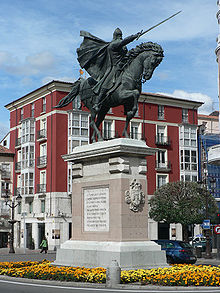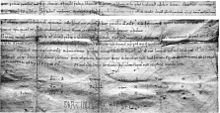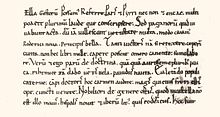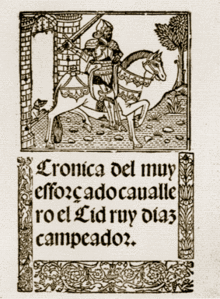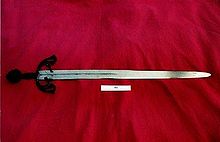- El Cid
-
Rodrigo Díaz de Vivar (AD. 1043 – July 10, 1099), known as El Cid Campeador (Spanish pronunciation: [el θið kampeaˈðor], "The lord-master of military arts"), was a Castilian nobleman, military leader, and diplomat. Exiled from the court of the Spanish Emperor Alfonso VI of León and Castile, El Cid went on to command a Moorish force consisting of Muladis, Berbers, Arabs and Malians, under Yusuf al-Mu'taman ibn Hud, Moorish king of the northeast Al-Andalus city of Zaragoza, and his successor, Al-Mustain II.
After the Christian defeat at the Battle of Sagrajas, El Cid was recalled to service by Alfonso VI, and commanded a combined Christian and Moorish army, which he used to create his own fiefdom in the Moorish Mediterranean coastal city of Valencia.
Rodrigo Díaz was educated in the royal court of Castile and became the alférez, the chief general, of Alfonso VI, and his most valuable asset in the fight against the Moors.
Contents
Title
The name El Cid (Spanish: [el 'θid]) comes from the Spanish or Arabic article el (meaning "the"), and the dialectal Arabic word سيد sîdi or sayyid, which means "Lord" or "The Master". The title Campeador means "champion" or "challenger" in Spanish. Because of his exceeding prowess in arms, he was the natural challenger in single combats. In Spanish warfare, it was common for leaders of armies to pit two Champions against each other (similar to the story of David and Goliath) to determine the outcome of the conflict. This way neither side would lose a great number of men. The Cid was the champion of King Alfonso IV of Castile. He had gained the title of "Campeador" when he fought on behalf of Alfonso against the forces of Granada. He defeated his enemy disastrously, gathered much treasure, and captured Count García Ordóñez, leader of the Granadian army. He pulled Ordóñez' beard in the ultimate insult of those days, then returned to Burgos, the Castilian capital.
Life and career
Origins
El Cid was born 1043 AD in Vivar, also known as Castillona de Bivar, a small town about six miles north of Burgos, the capital of Castile. His father, Diego Laínez, was a courtier, bureaucrat, and cavalryman who had fought in several battles. Despite the fact that El Cid's mother's family was aristocratic, in later years the peasants would consider him one of their own. However, his relatives were not major court officials; documents show that El Cid's paternal grandfather, Lain, confirmed only five documents of Ferdinand I's, his maternal grandfather, Rodrigo Alvarez, certified only two of Sancho II's, and El Cid's own father confirmed only one.
Service under Sancho II
As a young adult in 1057, Rodrigo fought against the Moorish stronghold of Zaragoza, making its emir al-Muqtadir a vassal of Sancho. In the spring of 1063, Rodrigo fought in the Battle of Graus, where Ferdinand's half-brother, Ramiro I of Aragon, was laying siege to the Moorish town of Cinca which was in Zaragozan lands. Al-Muqtadir, accompanied by Castilian troops including El Cid, fought against the Aragonese. The party would emerge victorious; Ramiro I was killed and the Aragonese fled the field. One legend has said that during the conflict, El Cid killed an Aragonese knight in single combat, thereby receiving the honorific title Campeador.
When Ferdinand died, Sancho continued to enlarge his territory, conquering both Christian and the Moorish cities of Zamora and Badajoz. When Sancho learned that Alfonso was planning on overthrowing him in order to gain his territory, Sancho sent Cid to bring Alfonso back so that Sancho could speak to him.
Service under Alfonso VI
Sancho was assassinated in 1072, as the result of a pact between his brother Alfonso and his sister Urraca; In any case, since Sancho died unmarried and childless, all of his power passed to his brother Alfonso.
Almost immediately, Alfonso returned from exile in Toledo and took his seat as king of Castile and León. He was deeply suspected in Castile, probably correctly,[citation needed] of having been involved in Sancho's murder. According to the epic of El Cid, the Castilian nobility led by El Cid and a dozen "oath-helpers" forced Alfonso to swear publicly in front of Santa Gadea (Saint Agatha) Church in Burgos on holy relics multiple times that he did not participate in the plot to kill his brother. This is widely reported[who?] as truth, but contemporary documents on the lives of both Rodrigo Diaz and Alfonso VI of Castile and León do not mention any such event. El Cid's position as armiger regis was taken away and given to El Cid's enemy, Count García Ordóñez.
Exile
In the Battle of Cabra (1079), El Cid rallied his troops and turned the battle into a rout of Emir Abdulallh of Granada and his ally García Ordóñez. However, El Cid's unauthorized expedition into Granada greatly angered Alfonso, and May 8, 1080, was the last time El Cid confirmed a document in King Alfonso's court. This is the generally given reason for El Cid's exile, although several others are plausible and may have been contributing factors: jealous nobles turning Alfonso against El Cid, Alfonso's own animosity towards El Cid, and an accusation of pocketing some of the tribute from Seville.
At first he went to Barcelona, where Ramón Berenguer II (1076–1082) and Berenguer Ramón II (1076–1097) refused his offer of service. Then he journeyed to the Taifa of Zaragoza where he received a warmer welcome by its diverse and well cultured inhabitants.
According to Moorish accounts:
Andalusian Knights found El Cid their foe ill, thirsty and exiled from the court of Alfonso, he was presented before the elderly Yusuf al-Mu'taman ibn Hud and accepted command of the forces of the Taifa of Zaragoza as their Master.
However, the exile was not the end of El Cid, either physically or as an important figure. In 1081, El Cid, went on to offer his services to the Moorish king of the northeast Al-Andalus city of Zaragoza, Yusuf al-Mu'taman ibn Hud, and served both him and his successor, Al-Mustain II. He was given the title El Cid (The Master) and served as a leading figure in a vibrant Moorish force consisting of Muladis, Berbers, Arabs and Malians.
O'Callaghan writes:
That kingdom was divided between al-Mutamin (1081–1085) who ruled Zaragoza proper, and his brother al-Mundhir, who ruled Lérida and Tortosa. El Cid entered al-Mutamin's service and successfully defended Zaragoza against the assaults of al-Mundhir, Sancho I of Aragón, and Ramón Berenguer II, whom he held captive briefly in 1082. In 1084, El Cid and the Moorish armies defeated Sancho of Aragon at the Battle of Morella near Tortosa. He was then troubled by the fierce conflicts between the Muladis of Badajoz and the Arabs of Seville.
In 1086, the Almoravid invasion of the Iberian Peninsula through and around Gibraltar began. The Almoravids, Berber residents of present-day North Africa, led by Yusuf ibn Tashfin, were asked to help defend the divided Moors from Alfonso. El Cid had probably commanded a large Moorish force during the great Battle of Sagrajas, which took place in 1086, near the Taifa of Badajoz. The Almoravid and Andalusian Taifas, including the armies of Badajoz, Málaga, Granada, Tortosa and Seville, defeated a combined army of León, Aragón and Castile.
Terrified after his crushing defeat, Alfonso recalled from exile the best Christian general: El Cid. It has been shown that El Cid was at court on July 1087; however, what happened after that is unclear.
Conquest of Valencia
File:El Cid ordering the Execution of Ahmed.jpgEngraving by Alphonse-Marie-Adolphe de Neuville of El Cid ordering the execution of the instigator of the revolt and almoravid after his conquest of the city in 1094.Around this time, El Cid, with a combined Christian and Moorish army, began maneuvering in order to create his own fiefdom in the Moorish Mediterranean coastal city of Valencia. Several obstacles lay in his way. First was Berenguer Ramón II, who ruled nearby Barcelona. In May 1090, El Cid defeated and captured Berenguer in the Battle of Tébar (nowadays Pinar de Tévar, near Monroyo, Teruel). Berenguer was later released and his nephew Ramón Berenguer III married El Cid's youngest daughter Maria to ward against future conflicts.
Along the way to Valencia, El Cid also conquered other towns, many of which were near Valencia, such as Castejón and Alucidia.
El Cid gradually came to have more influence on Valencia, then ruled by al-Qadir. In October 1092 an uprising occurred in Valencia inspired by the city's chief judge Ibn Jahhaf and the Almoravids. El Cid began a siege of Valencia. A December 1093 attempt to break the siege failed. By the time the siege ended in May 1094, El Cid had carved out his own principality on the coast of the Mediterranean. Officially El Cid ruled in the name of Alfonso; in reality, El Cid was fully independent. The city was both Christian and Muslim, and both Moors and Christians served in the army and as administrators.
Death
El Cid and his wife Jimena Díaz lived peacefully in Valencia for three years until the Almoravids besieged the city. El Cid was fighting one of the men when he was shot in the heart with an arrow. Valencia's troops were losing spirit when Jimena thought if she set the corpse of El Cid atop his horse Babieca, the morale of Valencia's troops would soar. Alfonso ordered the city burned to prevent it from falling into the hands of the Almoravids. Valencia was captured by Masdali on May 5, 1102 and it did not become a Christian city again for over 125 years. Jimena fled to Burgos with her husband's body. Originally buried in Castile in the monastery of San Pedro de Cardeña, his body now lies at the center of the Burgos Cathedral.
Warrior and general
Battle tactics
During his campaigns, El Cid often ordered that books by classic Roman and Greek authors on military themes be read aloud to him and his troops, for both entertainment and inspiration before battle. El Cid's army had a novel approach to planning strategy as well, holding what might be called brainstorming sessions before each battle to discuss tactics. They frequently used unexpected strategies, engaging in what modern generals would call psychological warfare — waiting for the enemy to be paralyzed with terror and then attacking them suddenly; distracting the enemy with a small group of soldiers, etc. (El Cid used this distraction in capturing the town of Castejón as depicted in Cantar de Mio Cid (The Song of my Cid)). El Cid accepted or included suggestions from his troops. In The Song the man who served him as his closest adviser was his vassal and kinsman Álvar Fáñez "Minaya" (meaning "My brother", a compound word of Spanish possessive Mi (My) and Anaia, the basque word for brother), although the historical Álvar Fáñez remained in Castile with Alfonso VI.
Taken together, these practices imply an educated and intelligent commander who was able to attract and inspire good subordinates, and who would have attracted considerable loyalty from his followers, including those who were not Christian. It is these qualities, coupled with El Cid's legendary martial abilities, which have fueled his reputation as an outstanding battlefield commander.
Babieca
Babieca or Bavieca was El Cid's warhorse. Several stories exist about El Cid and Babieca. One well-known legend about El Cid describes how he acquired the stallion. According to this story, Rodrigo's godfather, Pedro El Grande, was a monk at a Carthusian monastery. Pedro's coming-of-age gift to El Cid was his pick of a horse from an Andalusian herd. El Cid picked a horse that his godfather thought was a weak, poor choice, causing the monk to exclaim "Babieca!" (stupid!) Hence, it became the name of El Cid's horse. Another legend states that in a competition of battle to become King Sancho's "Campeador", or champion, a knight on horseback wished to challenge El Cid. The King wished a fair fight and gave El Cid his finest horse, Babieca, or Bavieca. This version says Babieca was raised in the royal stables of Seville and was a highly trained and loyal war horse, not a foolish stallion. The name in this instance could suggest that the horse came from the Babia region in León, Spain. In the poem Carmen Campidoctoris, Babieca appears as a gift from "a barbarian" to El Cid, so its name could also be derived from "Barbieca", or "horse of the barbarian".
Regardless, Babieca became a great warhorse, famous to the Christians, feared by El Cid's enemies, and loved by El Cid, who allegedly requested that Babieca be buried with him in the monastery of San Pedro de Cardeña.[citation needed] His name is mentioned in several tales and historical documents about El Cid, including The Lay of El Cid.
Swords
A weapon traditionally identified as El Cid's sword, Tizona, used to be displayed in the Army Museum (Museo del Ejército) in Toledo. In 1999, a small sample of the blade underwent metallurgical analysis which confirmed that the blade was made in Moorish Córdoba in the eleventh century and contained amounts of Damascus steel.[citation needed]
In 2007 the Autonomous Community of Castile and León bought the sword for 1.6 million Euros, and it is currently on display at the Museum of Burgos.
El Cid also had a sword called Colada.
Marriage and family
El Cid was married in July 1075 to Alfonso's kinswoman Jimena Díaz. The Historia Roderici calls her a daughter of a Count Diego of Oviedo, a person unknown to contemporary records, while later poetic sources name her father as an otherwise unknown Count Gomez de Gormaz.
Tradition states that when El Cid first laid eyes on her, he was enamored of her great beauty. Together El Cid and Jimena had three children. Their daughters Cristina and María both married into the high nobility; Cristina to Ramiro, Lord of Monzón, grandson of García Sánchez III of Navarre via an illegitimate son; María, first (it is said) to a prince of Aragon (presumably the son of Peter I) and second to Ramón Berenguer III, count of Barcelona. El Cid's son Diego Rodríguez was killed while fighting against the invading Muslim Almoravids from North Africa at the Battle of Consuegra (1097).
El Cid's own marriage and those of his daughters raised his status by connecting him to the peninsular royalty; even today, most European monarchs and many commoners of European ancestry descend from El Cid, through Cristina's son, King García Ramírez of Navarre and to a lesser extent via a granddaughter Jimena of Barcelona, who married into the Counts of Foix.
References
Bibliography
- Simon Barton and Richard Fletcher. The world of El Cid, Chronicles of the Spanish reconquest. Manchester: University Press, 2000. ISBN 0-7190-5225-4 hardback, ISBN 0-7190-5226-2 paperback.
- Gonzalo Martínez Díez, "El Cid Histórico: Un Estudio Exhaustivo Sobre el Verdadero Rodrigo Díaz de Vivar", Editorial Planeta (Spain, June 1999). ISBN 84-08-03161-9
- Richard Fletcher. "The Quest for El Cid". ISBN 0-19-506955-2
- Kurtz, Barbara E. El Cid. University of Illinois.
- I. Michael. The Poem of El Cid. Manchester: 1975.
- C. Melville and A. Ubaydli (ed. and trans.), Christians and Moors in Spain, vol. III, Arabic sources (711-1501). (Warminster, 1992).
- Joseph F. O'Callaghan. A History of Medieval Spain. Ithaca: Cornell University Press, 1975
- Peter Pierson. The History of Spain. Ed. John E. Findling and Frank W. Thacheray. Wesport, Connecticut: Greenwood Press, 1999. 34-36.
- Bernard F. Reilly. The Kingdom of León-Castilla under King Alfonso VI, 1065-1109 Princeton, New Jersey: University Press, 1988.
- The Song of El Cid. Translated by Burton Raffel. Penguin Classics, 2009.
- R. Selden Rose and Leonard Bacon (trans.) The Lay of El Cid. Semicentennial Publications of the University of California: 1868-1918. Berkeley, CA: University of California Press, 1997.
- Steven Thomas. 711-1492: Al-Andalus and the Reconquista.
- M. J. Trow,El Cid The Making of a Legend, Sutton Publishing Limited, 2007.
- Henry Edwards Watts. "The Story of El Cid (1026-1099)" in The Christian Recovery of Spain: The Story of Spain from the Moorish Conquest to the Fall of Grenada (711-1492 AD). New York: Putnam, 1894. 71-91.
- Cantar de mío Cid - Spanish (free PDF)
- Poema de Mio Cid, Códice de Per Abbat in the European Library (third item on page)
- T.Y. Henderson. "Conquests Of Valencia"
Sources and external links
Notes
Categories:- 1040s births
- 1099 deaths
- 11th-century Roman Catholics
- 11th-century Spanish people
- Characters in epic poems
- Medieval legends
- Military history of Spain
- People of the Reconquista
- Spanish folklore
- Spanish knights
- Spanish Roman Catholics
Wikimedia Foundation. 2010.

